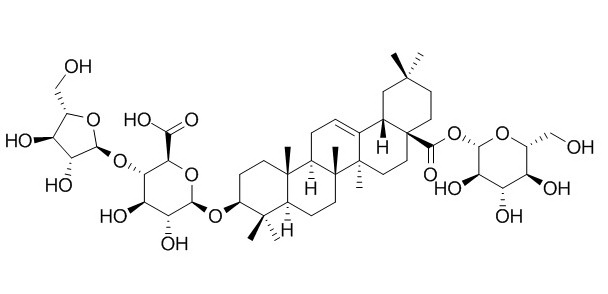Chikusetsusaponin IV
Chikusetsusaponin IV may relieve cutaneous symptoms caused by excessive apoptotic cell death in the skin through the Fas/FasL pathway.
Inquire / Order:
manager@chemfaces.com
Technical Inquiries:
service@chemfaces.com
Tel:
+86-27-84237783
Fax:
+86-27-84254680
Address:
1 Building, No. 83, CheCheng Rd., Wuhan Economic and Technological Development Zone, Wuhan, Hubei 430056, PRC
Providing storage is as stated on the product vial and the vial is kept tightly sealed, the product can be stored for up to
24 months(2-8C).
Wherever possible, you should prepare and use solutions on the same day. However, if you need to make up stock solutions in advance, we recommend that you store the solution as aliquots in tightly sealed vials at -20C. Generally, these will be useable for up to two weeks. Before use, and prior to opening the vial we recommend that you allow your product to equilibrate to room temperature for at least 1 hour.
Need more advice on solubility, usage and handling? Please email to: service@chemfaces.com
The packaging of the product may have turned upside down during transportation, resulting in the natural compounds adhering to the neck or cap of the vial. take the vial out of its packaging and gently shake to let the compounds fall to the bottom of the vial. for liquid products, centrifuge at 200-500 RPM to gather the liquid at the bottom of the vial. try to avoid loss or contamination during handling.
BMC Plant Biol.2021, 21(1):60.
Molecules.2019, 24(10):E1930
J Med Food.2019, 22(10):1067-1077
Int Immunopharmacol.2020, 90:107268.
Mol Cell.2017, 68(4):673-685
Nat Prod Sci.2018, 24(2):109-114
J Ethnopharmacol.2020, 249:112381
Front Pharmacol.2018, 9:756
Int J Mol Sci.2024, 25(16):8846.
Mol Nutr Food Res.2024, 68(20):e2400414.
Related and Featured Products
Planta Med. 2006 Feb;72(3):193-8.
Suppression of Fas-mediated apoptosis of keratinocyte cells by chikusetsusaponins isolated from the roots of Panax japonicus.[Pubmed:
16534721]
Activity-guided fractionation led to the isolation of Chikusetsusaponin IV, Chikusetsusaponin IVa, chikusetsusaponin V and polysciasaponin P5 as the active ingredients.
METHODS AND RESULTS:
Of these compounds, Chikusetsusaponin IV, was most active when applied at a concentration of 12.5 microg/mL. The intracellular hallmark events of apoptosis such as DNA fragmentation and chromatin condensation were significantly reduced by the treatment with Chikusetsusaponin IV. The apoptotic cell death of Jurkat cells was also suppressed by treatment with the active saponins.
CONCLUSIONS:
These results suggest that the use of Chikusetsusaponin IV, Chikusetsusaponin IVa, chikusetsusaponin V, polysciasaponin P5, or a crude extract of P. japonicus containing these saponins is expected to relieve cutaneous symptoms caused by excessive apoptotic cell death in the skin through the Fas/FasL pathway.
Biomed Res . 2010 Apr;31(2):155-9.
Inhibition of human renin activity by saponins[Pubmed:
20460744]
Abstract
Renin is the most important enzyme in the renin-angiotensin system. Our previous study led to the identification of soyasaponin I, the first renin inhibitor isolated from soybean. In the present study, the effects of saponins and sapogenols on human renin activities were investigated. Soyasaponins I and II, glycyrrhizin, monoglucuronyl glycyrrhetic acid (MGGA), Chikusetsusaponin IV, and Kochia scoparia fruit saponins (momordins) were found to inhibit renin activity. On the other hand, sapogenols (soyasapogenol B and glycyrrhetic acid), saikosaponins b2 and c, and ginsenoside Rb(1) had no effect on renin activity. These results clearly indicate that the 3-O-beta-dglucopyranosiduronic moiety in saponins (glucuronide saponin) is essential for renin inhibition.
Biomedical Chromatography, Volume 27, Number 11, 1 November 2013, pp. 1568-1573(6)
Determination of chikusetsusaponin V and chikusetsusaponin IV in rat plasma by liquid chromatography–mass spectrometry and its application to a preliminary pharmacokinetic study[Reference:
WebLink]
METHODS AND RESULTS:
A sensitive liquid chromatography–electrospray ionization–mass spectrometry method has been developed and validated for determination of two major bioactive saponins in rat plasma after oral administration of saponins extracted from Rhizoma Panacis Japonici, including chikusetsusaponin V and Chikusetsusaponin IV for the first time. Akebia saponin D was used as the internal standard (IS). Plasma samples were prepared by protein precipitation with methanol. A Phenomenex C18 column (150 × 4.6 mm, 4 μm) was used as the analytical column with a mobile phase of acetonitrile and 0.05% aqueous formic acid. Mass spectrometric detection was achieved by single quadrupole mass spectrometer equipped with an electrospray ionization interface operating in negative ionization mode. Calibration curves showed good linearity over the concentration range of 5–500 ng/mL for the two analytes in rat plasma. The lower limit of quantification was 5 ng/mL. The intra‐ and inter‐batch precisions were within 10.3% and accuracy ranged from −3.9 to 5.4%.
CONCLUSIONS:
The method was validated and successfully applied to the preliminary pharmacokinetic study of chikusetsusaponin V and Chikusetsusaponin IV in rat plasma after oral administration of saponins extracted from Rhizoma Panacis Japonici.



